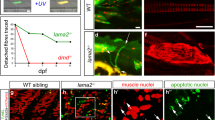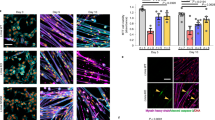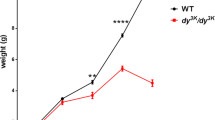Abstract
Integrin α7β1 is a specific cellular receptor for the basement membrane protein laminin-1 (refs 1,2), as well as for the laminin isoforms -2 and -4 (ref. 3). The α7 subunit is expressed mainly in skeletal and cardiac muscle4 and has been suggested to be involved in differentiation and migration processes during myogenesis5,6.Three cytoplasmic and two extracellular splice variants that have been described are developmentally regulated and expressed in different sites in the muscle7–9. In adult muscle, the α7A and α7B subunits are concentrated in myotendinous junctions10 but can also be detected in neuromuscular junctions and along the sarcolemmal membrane11. To study the potential involvement of α7 integrin during myogenesis and its role in muscle integrity and function, we generated a null allele of the α7 gene (ItgaT) in the germline of mice by homologous recombination in embryonic stem (ES) cells. Surprisingly, mice homozygous for the mutation are viable and fertile, indicating that the α7β1 integrin is not essential for myogenesis. However, histological analysis of skeletal muscle revealed typical symptoms of a progressive muscular dystrophy starting soon after birth, but with a distinct variability in different muscle types. The observed histopathological changes strongly indicate an impairment of function of the myotendinous junctions. These findings demonstrate that αβ1 integrin represents an indispensable linkage between the muscle fibre and the extracellular matrix that is independent of the dystrophin–dystroglycan complex–mediated interaction of the cytoskeleton with the muscle basement membrane.
This is a preview of subscription content, access via your institution
Access options
Subscribe to this journal
Receive 12 print issues and online access
$209.00 per year
only $17.42 per issue
Buy this article
- Purchase on Springer Link
- Instant access to full article PDF
Prices may be subject to local taxes which are calculated during checkout
Similar content being viewed by others
References
von der Mark, H. et al. Skeletal myoblasts utilize a novel beta 1-series integrin and not alpha 6 beta 1 for binding to the E8 and T8 fragments of laminin. J. Biol. Chem. 266, 23593–23601 (1991).
Kramer, R.H. et al. Laminin-binding integrin alpha 7 beta 1: functional characterization and expression in normal and malignant melanocytes. Cell Regul. 2, 805–817 (1991).
Yao, C.C., Ziober, B.L., Squillace, R.M. & Kramer, R.H. Alphα integrin mediates cell adhesion and migration on specific laminin isoforms. J. Biol. Chem. 271, 25598–25603 (1996).
Song, W.K., Wang, W., Foster, R.F., Bielser, D.A. & Kaufman, S.J. H36-alpha 7 is a novel integrin alpha chain that is developmentally regulated during skeletal myogenesis. J. Cell Biol. 117, 643–657 (1992).
Ocalan, M., Goodman, S.L., Kuhl, U., Hauschka, S.D. & von der Mark, K. Laminin alters cell shape and stimulates motility and proliferation of murine skeletal myoblasts. Deiv. Biol. 125, 158–167 (1988).
Goodman, S.L., Risse, G. & von der Mark, K. The E8 subfragment of laminin promotes locomotion of myoblasts over extracellular matrix. J. Cell Biol. 109, 799–809 (1989).
Collo, G., Starr, L. & Quaranta, V. A new isoform of the laminin receptor integrin alpha 7 beta 1 is developmentally regulated in skeletal muscle. J. Biol. Chem. 268, 19019–19024 (1993).
Ziober, B.L. et al. Alternative extracellular and cytoplasmic domains of the integrin alpha 7 subunit are differentially expressed during development. J. Biol. Chem. 268, 26773–26783 (1993).
Song, W.K., Wang, W., Sato, H., Bielser, D.A. & Kaufman, S.J. Expression of alpha 7 integrin cytoplasmic domains during skeletal muscle development: alternate forms, conformational change, and homologies with serine/threonine kinases and tyrosine phosphatases. J. Cell Sci. 106, 1139–1152 (1993).
Bao, Z.Z., Lakonishok, M., Kaufman, S. & Horwitz, A.F. Alpha 7 beta 1 integrin is a component of the myotendinous junction on skeletal muscle. J. Cell Sci. 106, 579–589 (1993).
Martin, P.T., Kaufman, S.J., Kramer, R.H. & Sanes, J.R. Synaptic integrins in developing, adult, and mutant muscle: selective association of alpha1, alpha7A,and alpha7B integrins with the neuromuscular junction. Dev. Biol. 174, 125–139 (1996).
Ziober, B.L. & Kramer, R.H. Identification and characterization of the cell type–specific and developmentally regulated alpha7 integrin gene promoter. J. Biol. Chem. 271, 22915–22922 (1996).
Fässler, R. & Meyer, M. Consequences of lack of beta 1 integrin gene expression in mice. Genes Dev. 9, 1896–1908 (1995).
Stedman, H.H. et al. The mdx mouse diaphragm reproduces the degenerative changes of Duchenne muscular dystrophy. Nature 352, 536–539 (1991).
Tidball, J.G. Assembly of myotendinous junctions in the chick embryo: deposition of P68 is an early event in myotendinous junction formation. Dev. Biol. 163, 447–456 (1994).
Law, D.J. & Tidball, J.G. Dystrophin deficiency is associated with myotendinous junction defects in prenecrotic and fully regenerated skeletal muscle. Am. J. Pathol. 142, 1513–1523 (1993).
Brabant, M.C. & Brower, D.L. PS2 integrin requirements in Drosophila embryo and wing morphogenesis. Dev. Biol. 157, 49–59 (1993).
Volk, T., Fessler, L.I. & Fessler, J.H. A role for integrin in the formation of sarcomeric cytoarchitecture. Cell. 63, 525–536 (1990).
Erickson, H.P. & Bourdon, M.A. Tenascin: an extracellular matrix protein prominent in specialized embryonic tissues and tumors. Annu. Rev. Cell Biol. 5, 71–92 (1989).
Sanes, J.R., Schachner, M. & Covault, J. Expression of several adhesive macromolecules (N-CAM, L1, J1, NILE, uvomorulin, laminin, fibronectin, and a heparan sulfate proteoglycan) in embryonic, adult, and denervated adult skeletal muscle. J. Cell Biol. 102, 420–431 (1986).
Settles, D.L., Cihak, R.A. & Erickson, H.P. Tenascin-C expression in dystrophinrelated muscular dystrophy. Muscle Nerve. 19, 147–154 (1996).
Monaco, A.P. et al. Isolation of candidate cDNAs for portions of the Duchenne muscular dystrophy gene. Nature 323, 646–650 (1986).
Ibraghimov-Beskrovnaya, O. et al. Primary structure of dystrophin-associated glycoproteins linking dystrophin to the extracellular matrix. Nature 355, 696–702 (1992).
Helbling-Leclerc, A. et al. Mutations in the laminin α2-chain gene (LAMA2) cause merosin-deficient congenital muscular dystrophy. Nature Genet. 11, 216–218 (1995).
Campbell, K.P. Three muscular dystrophies: loss of cytoskeleton-extracellular matrix linkage. Cell 80, 675–679 (1995).
Nagy, A., Rossant, J., Nagy, R., Abramow-Newerly, W. & Roder, J.C. Derivation of completely cell culture-derived mice from early-passage embryonic stem cells. Proc. Natl. Acad. Sci. USA 90, 8424–8428 (1993).
Echtermeyer, F., Schöber, S., Pöschl, E., von der Mark, H. . & von der Mark, K. Specific induction of cell motility on laminin by alpha 7 integrin. J. Biol. Chem. 271, 2071–2075 (1996).
Fox, J.W. et al. Recombinant nidogen consists of three globular domains and mediates binding of laminin to collagen type IV. EMBO J. 10, 3137–3146 (1991).
Talts, J.F., Eng, H., Zhang, H.-Y., Faissner, A. & Ekblom, P. Characterization of monoclonal antibodies against tenascin-C: no apparent effect on kidney development in vitro. Int. J. Dev. Biol. 41, 39–48 (1997).
Karnovsky, M. A formaldehyde-glutaraldehyde fixative of high osmolality for use in electron microscopy. Acta Histochem. 88, 25–27 (1965).
Author information
Authors and Affiliations
Corresponding author
Rights and permissions
About this article
Cite this article
Mayer, U., Saher, G., Fässler, R. et al. Absence of integrin α7 causes a novel form of muscular dystrophy. Nat Genet 17, 318–323 (1997). https://doi.org/10.1038/ng1197-318
Received:
Accepted:
Issue Date:
DOI: https://doi.org/10.1038/ng1197-318
This article is cited by
-
The role of the dystrophin glycoprotein complex in muscle cell mechanotransduction
Communications Biology (2022)
-
In vivo partial reprogramming of myofibers promotes muscle regeneration by remodeling the stem cell niche
Nature Communications (2021)
-
Using Tools in Mechanobiology to Repair Tendons
Current Tissue Microenvironment Reports (2020)
-
Featured characteristics and pivotal roles of satellite cells in skeletal muscle regeneration
Journal of Muscle Research and Cell Motility (2020)
-
Meta-analysis of 542,934 subjects of European ancestry identifies new genes and mechanisms predisposing to refractive error and myopia
Nature Genetics (2020)



